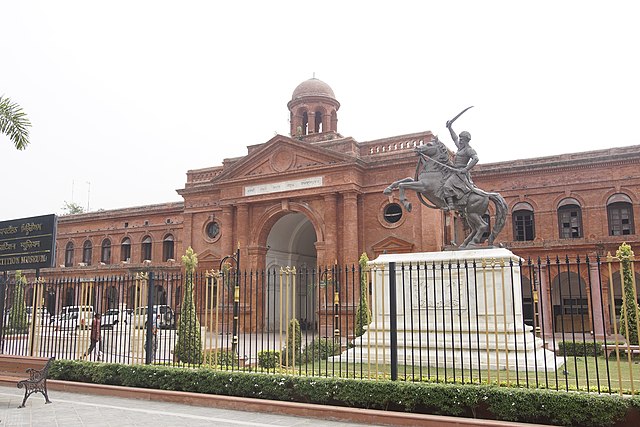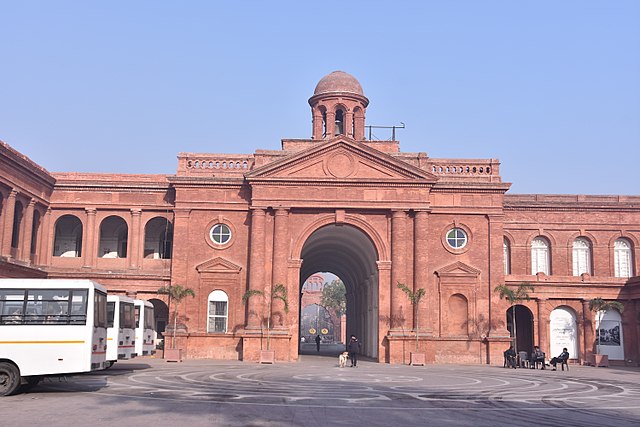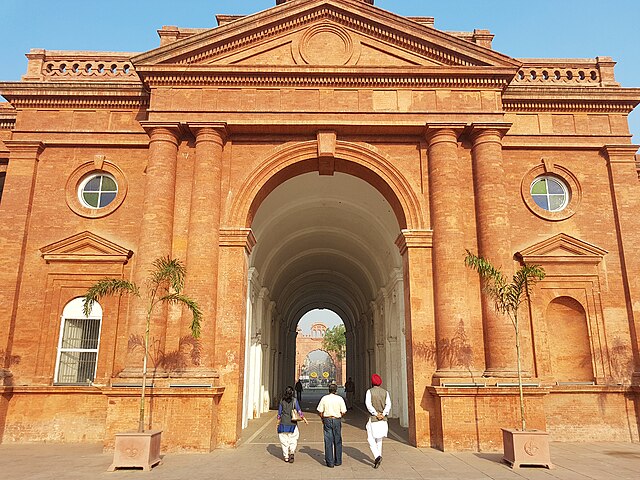Have you ever wondered what it feels like to walk through the pages of history? The Partition Museum in Amritsar isn’t just another tourist attraction – it’s a powerful testament to human resilience, pain, and hope. The Partition Museum is the world’s first Museum dedicated to the Partition of the Indian sub-continent in 1947. Located in the heart of Amritsar, this remarkable institution tells the story of one of humanity’s most significant migrations, affecting millions of lives across the Indian subcontinent.
Why should you care about visiting this museum? Because understanding our past helps us shape our future. The Partition Museum doesn’t just display artifacts; it preserves memories, honors sacrifices, and ensures that the voices of millions who lived through this tumultuous period are never forgotten.
The Historical Significance of 1947 Partition
Let’s set the stage, shall we? The year 1947 marked not just India’s independence but also one of the most traumatic events in human history. The Partition of India has been one of the most defining events in the history of the subcontinent. It was the largest mass migration in human history. Imagine entire communities packing their lives into suitcases, leaving behind everything they knew, hoping to find safety on the other side of newly drawn borders.
The partition created two nations – India and Pakistan – but at what cost? Families were torn apart, communities were displaced, and the social fabric of centuries was ripped apart overnight. The numbers are staggering: millions of people crossed borders, hundreds of thousands lost their lives, and countless others carried emotional scars for generations.
This wasn’t just a political decision; it was a human catastrophe that reshaped the destiny of an entire subcontinent. The Partition Museum captures this complexity, refusing to simplify what was inherently complicated and deeply personal for millions of people.
Why Amritsar Was Chosen as the Museum Location

You might ask, “Why Amritsar?” The answer lies in geography, history, and emotion. Amritsar sits just 32 kilometers from the Pakistan border – close enough to hear the echoes of partition across the fields. This proximity isn’t coincidental; it’s symbolic. The city witnessed firsthand the chaos, the tears, and the hope of those crossing borders.
Amritsar had always been a cultural melting pot, home to diverse communities living in harmony for centuries. When partition struck, it became a transit point for refugees, a place where stories of loss and survival converged. Choosing Amritsar for the museum wasn’t just about location – it was about authenticity.
The city’s spiritual significance, anchored by the Golden Temple, adds another layer of meaning. Where better to house stories of human faith and resilience than in a city that has been a beacon of hope for centuries?
Museum Architecture and Town Hall Heritage
Located at the Town Hall in Amritsar and developed by the Arts and Cultural Heritage Trust (TAACHT), the museum is a part of the newly inaugurated Heritage Street at Amritsar, which begins from the Golden Temple and ends at the Town Hall. Located in the historic Town Hall, the museum was opened in August 2017 to commemorate the seventieth anniversary of India’s partition.
The Town Hall itself is a piece of history. Built during the British era, this colonial-style building has witnessed the transformation of Amritsar from a colonial outpost to a vibrant modern city. By housing the Partition Museum here, the creators have added new chapters to this building’s story.
The architecture serves the narrative beautifully. The high ceilings and spacious halls provide the perfect backdrop for the museum’s exhibits, allowing visitors to move through the galleries like chapters in a book. The building’s colonial history creates an interesting juxtaposition – the very architectural style of the rulers who partitioned India now houses the stories of those affected by their decisions.
The Vision Behind Creating the Museum
What drives someone to create a museum about such a painful chapter in history? The vision behind the Partition Museum goes beyond mere documentation. It’s about healing, understanding, and ensuring that future generations learn from the past.
The museum’s creators understood that partition wasn’t just a political event – it was a deeply personal trauma that affected individuals, families, and entire communities. By focusing on human stories rather than political narratives, the museum creates space for empathy and understanding.
Think of it as a bridge – connecting the past with the present, the personal with the political, and pain with healing. The museum doesn’t shy away from difficult truths, but it also doesn’t leave visitors in despair. Instead, it offers hope by showing how people rebuilt their lives, maintained their dignity, and found ways to move forward despite unimaginable loss.
Exploring the Fourteen Galleries
Ready for a journey through time? The museum is divided into fourteen galleries: “Why Amritsar?, Punjab, Resistance (1900-1929), The Rise (1930-1945), Differences (1946), Prelude to Partition, Boundaries, Independence, Borders, Migrations, Divisions, Refuge, and Hope”. Each gallery tells a specific part of the partition story, creating a chronological narrative that helps visitors understand not just what happened, but why it happened.
The journey begins with “Why Amritsar?” – establishing the city’s significance and setting the stage for the stories to follow. As you move through the galleries, you’ll experience the rising tensions of the early 20th century, the growing differences that led to partition, and finally, the human cost of those political decisions.
What makes these galleries special isn’t just their content – it’s their approach. Rather than presenting dry historical facts, each gallery immerses you in the emotions and experiences of the time. You’ll hear voices of people who lived through partition, see their belongings, and understand their choices.
Gallery Highlights: Stories That Matter
Each gallery has its own character and focus. The “Resistance” gallery showcases the early struggles for independence, while “The Rise” explores the growing momentum of the freedom movement. But perhaps the most powerful galleries are those dealing with the human impact – “Migrations,” “Divisions,” and “Refuge.”
In the “Migrations” gallery, you’ll see maps showing the movement of millions of people, but more importantly, you’ll hear their stories. Why did they leave? What did they carry? How did they survive the journey? These aren’t just statistics – they’re human experiences that shaped the subcontinent’s future.
The “Hope” gallery serves as the museum’s emotional crescendo. After walking through galleries filled with pain and loss, visitors find stories of resilience, rebuilding, and the human capacity to start over. It’s a reminder that even in history’s darkest chapters, the human spirit finds ways to shine.
Interactive Exhibits and Multimedia Experiences
How do you make history come alive for modern visitors? The Partition Museum uses technology thoughtfully, integrating multimedia elements that enhance rather than overshadow the human stories. Visitors can enjoy seeing history recordings, listening to soundscapes in each gallery, reading letters from refugees, viewing official papers, and viewing other artworks, among other fascinating experiences.
The soundscapes are particularly powerful. Imagine walking through a gallery and hearing the actual voices of partition survivors sharing their memories. These aren’t actors or recreations – they’re real people talking about real experiences. The impact is immediate and profound.
Interactive displays allow visitors to explore maps, timelines, and personal accounts at their own pace. You might spend five minutes with one exhibit or half an hour, depending on what resonates with you. This personalized experience ensures that each visitor connects with the museum in their own way.
Personal Artifacts and Oral Histories
What would you grab if you had to leave your home forever with just minutes’ notice? The Partition Museum displays actual items that people carried during their displacement – family photographs, jewelry, documents, and everyday objects that suddenly became priceless memories.
The exhibits at the Partition Museum include newspaper clippings, photographs as well as personal items that were donated by people who had witnessed and lived during partition. These aren’t museum pieces acquired from dealers – they’re donations from families who wanted to share their stories with the world.
The oral history project is perhaps the museum’s most valuable contribution to historical preservation. Survivors and their descendants have shared thousands of hours of interviews, creating an irreplaceable archive of human experience. These stories add depth and authenticity that no textbook could ever achieve.
Visitor Information and Practical Details

Planning a visit? Let’s talk logistics. The museum is open daily except Mondays and national holidays, giving you plenty of opportunities to experience this remarkable institution. The location on Heritage Street makes it easy to combine with other Amritsar attractions, creating a full day of cultural exploration.
Entry Fees and Timing Guidelines
The entry charge for foreigners is INR 250 per ticket, and for Indian residents, it is INR 10. Children under the age of five are admitted free of charge. The Amritsar Partition Museum is open to visitors from 10 am to 6 pm. These affordable prices ensure that the museum remains accessible to people from all economic backgrounds.
The timing allows for both morning and afternoon visits, though many visitors recommend allowing at least 2-3 hours to fully experience all fourteen galleries. The museum isn’t something you can rush through – it demands time for reflection and processing.
Special Provisions for Partition Survivors
Here’s something beautiful: Admission to the Museum is free for those who survived the partition. This gesture goes beyond mere waiver of fees – it’s an acknowledgment of their sacrifice and a recognition of their contribution to the museum’s very existence.
For many survivors, visiting the museum is an emotional journey. The staff is trained to provide support and space for these special visitors, understanding that for them, this isn’t just history – it’s personal memory.
Photography and Documentation Policies
The museum has specific guidelines about photography and documentation, balancing the need for sharing stories with respect for the sensitive nature of the exhibits. While general photography might be restricted in certain areas, the museum encourages visitors to engage with the content thoughtfully and respectfully.
Educational Programs and Community Outreach
The Partition Museum isn’t just a repository of artifacts – it’s an active educational institution. The museum regularly organizes workshops, seminars, and educational programs for students, researchers, and the general public. These programs help extend the museum’s impact beyond its physical walls.
School groups are particularly welcomed, with specially designed programs that help young people understand this crucial period in history. The museum’s educational approach emphasizes critical thinking, empathy, and the importance of learning from the past to build a better future.
Community outreach programs bring partition stories to those who might not be able to visit the museum physically. Through traveling exhibitions, digital platforms, and community partnerships, the museum ensures that these important stories reach diverse audiences.
Impact and Recognition
Since its opening in 2017, the Partition Museum has received recognition from historians, educators, and cultural institutions worldwide. It has become a model for how museums can address difficult historical topics while maintaining sensitivity and authenticity.
The museum’s approach to presenting partition history has influenced similar initiatives across South Asia and beyond. By focusing on human stories rather than political narratives, it has created a template for museums dealing with traumatic historical events.
International visitors often comment on the museum’s ability to present complex historical events in accessible ways. The museum has become a destination not just for tourists but for researchers, historians, and anyone interested in understanding the human impact of political decisions.
Planning Your Visit: Tips and Recommendations
Want to make the most of your museum visit? Here are some insider tips. First, allow plenty of time – this isn’t a museum you can see in an hour. The emotional weight of the exhibits requires processing time, and rushing through defeats the purpose.
Come prepared emotionally. The stories you’ll encounter are powerful and sometimes difficult. It’s normal to feel moved, upset, or overwhelmed. The museum provides quiet spaces where visitors can reflect and process their emotions.
Consider visiting during less crowded hours if you prefer a more contemplative experience. Early mornings or late afternoons often provide more intimate encounters with the exhibits.
Nearby Attractions and Heritage Walk
Your museum visit can be part of a larger Amritsar experience. The Heritage Street connects the museum to the Golden Temple, creating a meaningful cultural journey. This walk takes you through centuries of Sikh history and culture, providing context for the partition stories you’ll encounter in the museum.
Other nearby attractions include Jallianwala Bagh, another site of historical trauma that adds layers to understanding Amritsar’s complex past. The proximity of these sites isn’t coincidental – together, they tell the story of a city that has witnessed some of history’s most significant moments.
Conclusion
The Partition Museum Amritsar stands as more than just a collection of artifacts and stories – it’s a testament to human resilience, a bridge between past and present, and a reminder of the importance of remembering difficult truths. In a world where history is often forgotten or sanitized, this museum courageously presents the complexity and humanity of one of the 20th century’s most significant events.
Your visit to the Partition Museum won’t just be educational – it will be transformational. You’ll leave with a deeper understanding of history, greater empathy for human experience, and perhaps most importantly, a renewed commitment to ensuring that the lessons of the past inform the choices of the future.
The museum’s success lies not in its ability to provide answers but in its courage to ask difficult questions. What does it mean to belong? How do political decisions affect individual lives? How do communities heal from trauma? These questions remain relevant today, making the museum’s message both historical and contemporary.
Whether you’re a history enthusiast, a casual tourist, or someone seeking to understand the roots of modern South Asia, the Partition Museum offers an experience that will stay with you long after you leave its halls. It reminds us that behind every historical event are real people with real stories – and those stories deserve to be told, heard, and remembered.
Frequently Asked Questions (FAQs)
1. What makes the Partition Museum unique compared to other historical museums?
The Partition Museum is the world’s first museum dedicated specifically to the 1947 partition of India. Unlike traditional museums that focus on artifacts and political narratives, this museum emphasizes personal stories, oral histories, and the human experience of partition. Its approach is deeply empathetic, allowing visitors to connect emotionally with historical events through multimedia experiences and authentic personal accounts.
2. How much time should I allocate for visiting the Partition Museum?
Plan to spend at least 2-3 hours at the museum to fully experience all fourteen galleries. The museum’s content is emotionally intensive and requires time for reflection and processing. Many visitors find that rushing through defeats the purpose, as the stories and exhibits are meant to be contemplated rather than simply viewed. Some visitors spend up to half a day, especially those with personal connections to partition history.
3. Is the museum suitable for children and sensitive visitors?
While the museum presents historical truth with sensitivity, it does address traumatic events including displacement, violence, and loss. Parents should use their discretion for young children. The museum provides content warnings where appropriate and has quiet spaces for reflection. The staff is trained to assist visitors who might find the content overwhelming, and the presentation focuses on resilience and hope alongside historical realities.
4. Can partition survivors and their families contribute to the museum’s collection?
Absolutely! The museum actively encourages donations of artifacts, photographs, documents, and oral histories from partition survivors and their families. These contributions form the heart of the museum’s authenticity. The museum has dedicated staff to work with families who wish to share their stories or donate items, ensuring that these contributions are properly preserved and respectfully displayed.
5. What educational programs does the museum offer for students and researchers?
The museum offers specialized educational programs for different age groups and academic levels. School programs include guided tours with age-appropriate content, interactive workshops, and curriculum-linked activities. For researchers, the museum provides access to its oral history archives, research facilities, and expert consultations. The museum also organizes seminars, lectures, and academic conferences focused on partition studies and related historical research.

